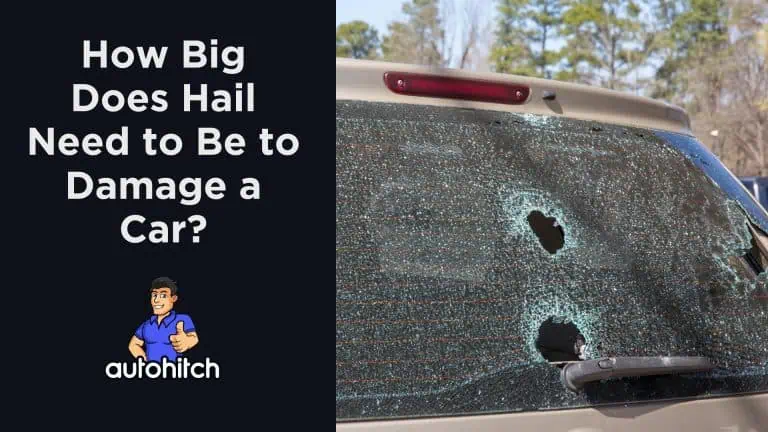The largest piece of hail to be photographed and recorded fell in Vivian, South Dakota, on July 23, 2010. This hailstone measured 8.0 inches in diameter, had a circumference of 18.625 inches, and weighed 1.9375 pounds!
Clearly, a chunk of hail this size would destroy any car, but:
How big does hail need to be to damage a car?
Answer:
Here is a detailed table showing various well-known sizes of hail and the potential damage each size can cause to a vehicle:
| Hail Size | Diameter (inches) | Description | Potential Vehicle Damage |
|---|---|---|---|
| Pea | 0.25 | Pea sized hail | Typically no damage, but can potentially cause minor dents or paint chips on soft spots like the roof, depending on storm severity and vehicle construction |
| Marble | 0.50 | Marble sized hail | Minor dents and dings possible, paint chips on exposed surfaces like hood and roof |
| Dime/Penny | 0.75 | Dime to penny sized hail | Noticeable small dents, paint chips and scratches likely on hood, roof, trunk; possible cracked glass |
| Nickel | 0.88 | Nickel sized hail | Moderate dents, paint damage, and cracks on windshield, windows, and body panels |
| Quarter | 1.00 | Quarter sized hail | Larger dents, more significant paint damage, cracked/chipped glass; can dent metal panels and crack windshields |
| Half Dollar | 1.25 | Half dollar sized hail | Major dents on all surfaces, severe paint damage, cracked/shattered windows and windshields |
| Walnut/Ping Pong Ball | 1.50 | Ping pong ball sized hail | Heavy dents and paint damage on all panels; high likelihood of shattered windows and windshields |
| Golf Ball | 1.75 | Golf ball sized hail | Severe widespread denting, major paint/glass damage; body panels may require replacement |
| Hen’s Egg | 2.00 | Egg sized hail | Extreme damage to all vehicle surfaces; high chance of shattered windows/windshields; dents will likely require body filler and repainting |
| Tennis Ball | 2.50 | Tennis ball sized hail | Devastating damage to exterior; windshields destroyed; major dents requiring extensive bodywork and repainting |
| Baseball | 2.75 | Baseball sized hail | Catastrophic damage to vehicle; most glass surfaces demolished; severe dents and structural damage likely |
| Tea Cup | 3.00 | Tea cup sized hail | Total destruction of exterior surfaces; high risk of damage to mechanical components from impacts |
| Grapefruit | 4.00 | Grapefruit sized hail | Vehicle likely totaled due to extreme structural damage; severe risk to occupants if driving |
| Softball | 4.50 | Softball sized hail | Vehicles completely destroyed; unsafe to drive due to glass/body destruction and mechanical damage |
To summarize the table above:
- While hail smaller than 1 inch can cause minor cosmetic damage like small dents and paint chips, the severity increases dramatically for hail 1 inch (quarter-sized) or larger.
- Hail 1.5 inches or greater will likely shatter windows and windshields in addition to causing major body damage.
- Hail exceeding 2 inches in diameter poses severe risk of irreparable structural damage that may render the vehicle unsafe to operate.
Minimum Size Hail to Damage a Car?
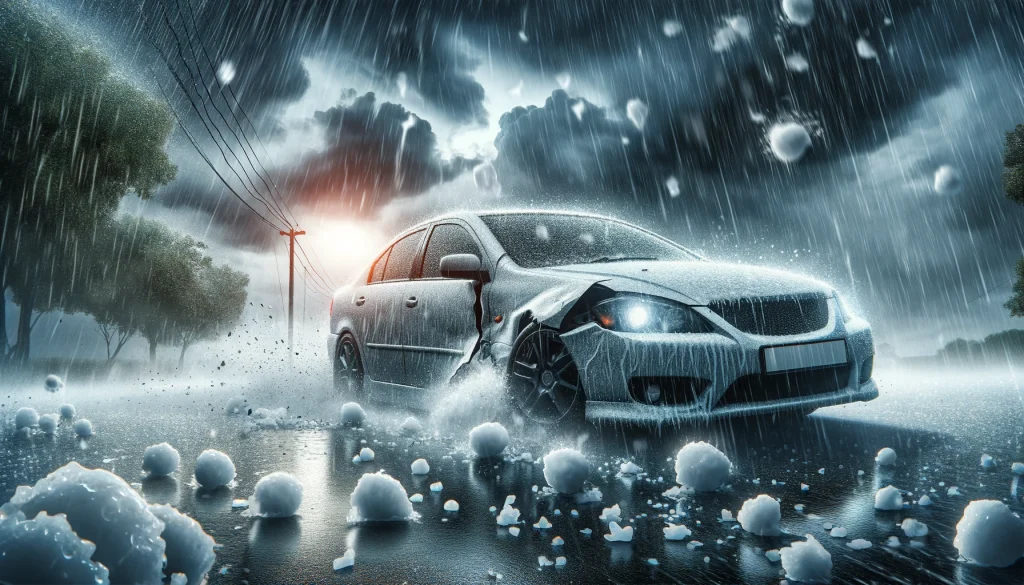
Typically, hail that is one inch (quarter-sized) or larger in diameter is considered sufficient to produce visible vehicle damage like dents and paint chipping.
Keep in mind that high density, slower falling hail has greater potential for harm than lighter ice pellets moving rapidly. For instance, a 1 inch dense hailstone driven by 50 mph winds can induce more damage than 2 inch low-density ice balls falling at 10 mph.
Table of Contents
Related Articles To Read:
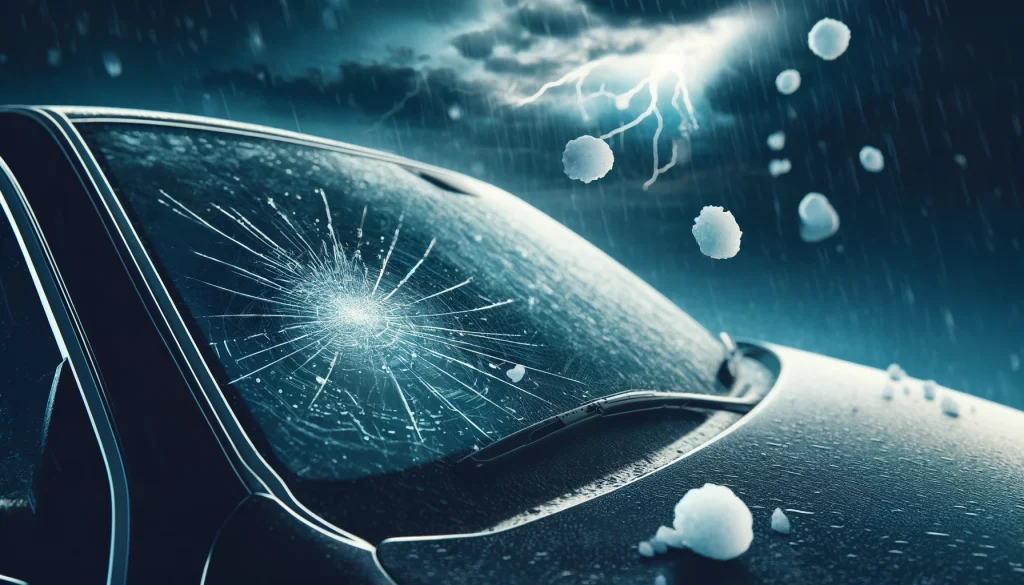
How Big Does Hail Have to Be to Damage a Windshield?
Hail that is approximately 1 inch in diameter (quarter-sized) or larger can potentially crack or shatter windshields, with the likelihood and severity of damage increasing as the hail size exceeds 1.5 inches (ping pong ball-sized).
Types of Vehicle Damage From Hail
Hailstones pummel vehicles randomly, so damage occurs based on each impact’s size, location, and other dynamics. Some areas suffer purely cosmetic damage, while others require structural repairs. Here are common categories:
Cosmetic Hail Damage
Minor exterior defects like small dents or paint chips concentrated in visible sections:
- Dents and Dings: Most prevalent damage, ranging from barely noticeable shallow dings to door-size basins. Severity rises for hail over 1 inch.
- Paint Chipping: Hailstones easily crack or scratch paint, exposing metal underneath to rust. Escalates with hail velocity.
- Cracked Glass/Plastic: Side mirrors, lights, and windshields fracture under sufficient impact force.
Structural Hail Damage
Internal or integral components damaged, affecting safety, and mechanical functionality:
- Frame warping: Hail can distort the foundation, misaligning car doors and panels.
- Mechanical/Electrical: If hail penetrates to engine components or wiring, it can inhibit performance.
While rarer than cosmetic damage, structural issues seriously reduce vehicle functionality, safety, and value.
How to Prevent Hail Damage to Vehicles
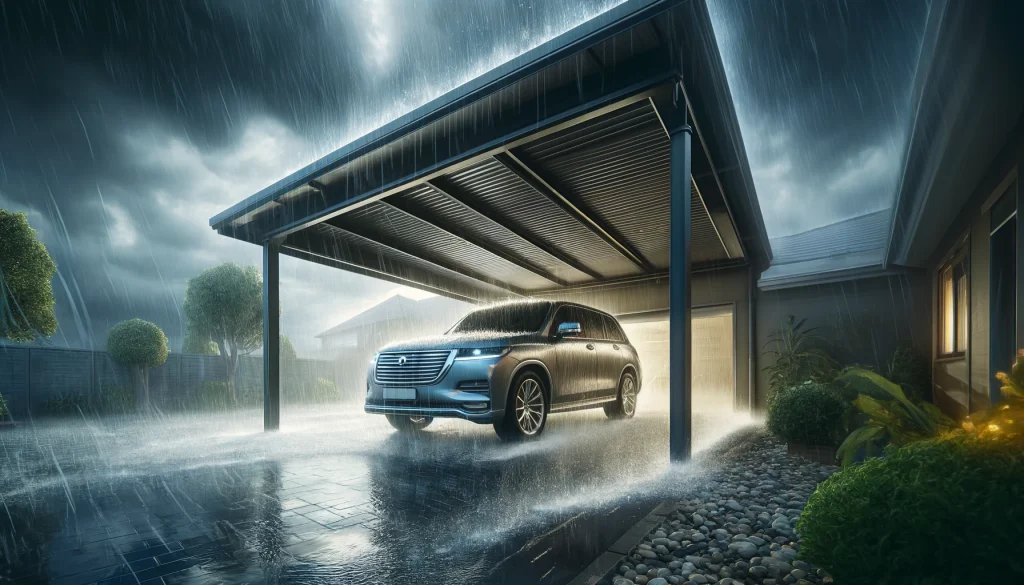
Ideally, vehicle owners in hail-prone areas prioritize protection to avoid repair expenses and maintain resale value. Consider these simple precautions:
- Park inside a garage when possible
- Use thick blankets or floor mats to cushion hail’s impact
- Buy a designated hail protection car cover
- Move the vehicle away from trees to avoid falling branches
- Radar forecast tracking to monitor for approaching storms
Finding shelter or using covers/padding are the most reliable methods, although not foolproof. Avoid pulling over under bridges/overpasses which attract lightning strikes.
How is Hail Damaged Assessed on a Car?
| Step | Area or Component | Assessment Detail | Repair Consideration |
|---|---|---|---|
| 1 | Main Body (hood, trunk, panels, bumpers) | Examine for dents and paint damage. Main focus due to high labor costs involved in repairing these areas. | Traditional dent repair or Paintless Dent Repair (PDR). |
| 2 | Glass Components (windshield, mirrors) | Check for cracks or breaks. Small cracks can expand, leading to bigger issues. | May require replacement if damage is severe. |
| 3 | Interior | Inspect for water damage which can affect upholstery and electrical systems. | Water damage repair, potential replacement of components. |
| 4 | Vehicle Panels | Quantify size and number of dents using a pricing matrix for repair cost estimation. | Choose appropriate repair method based on damage extent. |
| 5 | Type of Repairs Needed | Determine if minor damage can be fixed with PDR or if severe damage needs traditional repair and repainting. | PDR is quicker and cost-effective for minor dents. |
| 6 | Cost Calculation | Total repair costs including PDR labor, part removal/installation, part replacement, and taxes on parts. | Ensure comprehensive cost calculation for accurate insurance claims. |
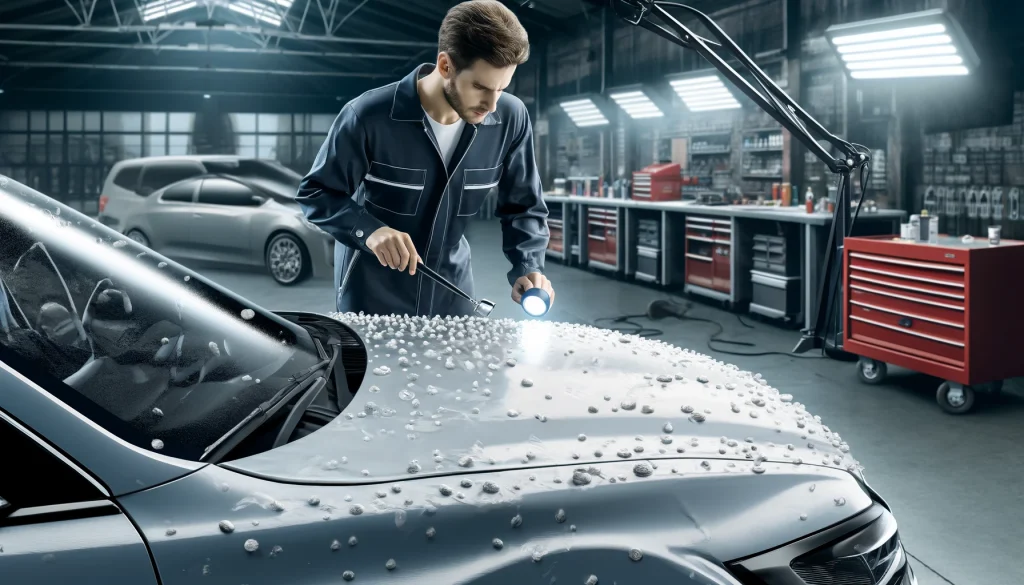
Repair Options
- Paintless Dent Repair (PDR) – Preferred method to remove dents by massaging metal back into shape without repainting. Costs $50-$150 per dent on average.
- Body Filler and Paint Repair – Necessary for eliminating scratches, chips, and cracks exposing metal. Avoid DIY painting which rarely matches factory finishes.
- Glass/Plastic Replacement – Cracked windshields require professional installation for safety.
PDR provides the most affordable and efficient option for purely cosmetic damage. However, significant structural damage necessitates body shop repairs.
Insurance Claims – Comprehensive auto insurance policies typically cover hail damage, after paying your deductible. Contact your provider for claim filing instructions and approved repair shops.
What’s the Average Cost To Repair Hail Damage on a Car?
Repair expenditures depend heavily on damage extent across various factors:
- Light/moderate damage limiting cosmetic defects falls around $4,000-$10,000
- Severe body deformation with mechanical issues often exceeds $8,000
- Average cost cited as $4,300 but varies based on dent count/size plus parts/labor
- Paintless dent repair (PDR) provides affordable dent removal with average cost of $50-$150 per dent
- Materials affect pricing – aluminum vehicles carry ~25% premium over steel
Comprehensive insurance covers hail minus deductible payments, though liability plans exclude storm repairs. Considering coverage limitations and the potential for expensive repairs illustrates why protective steps hold such importance.
How Long Do You Have to Claim Hail Damage on a Car?
Most insurance policies allow up to one year to report hail damage on a car. However, you should always read your specific policy to be 100% sure.
Statistics and Studies on Hail Damage to Vehicles
Hailstorms frequently target the same areas every year, with data showing significant financial and material impact in those regions:
- Annual hail losses average $10 billion in insured damages, with some years exceeding $15 billion
- Texas, Colorado, and Nebraska lead claims volume with over 50% of national total
- Between 2017 and 2019, around 735,000 personal auto and 26,000 commercial auto hail insurance claims were filed yearly
- Over 10.7 million properties were affected by one or more damaging hailstorm in 2017
Additional analysis of insurance data:
- Estimated national hail claim frequency reached 3.2 claims per 1,000 insured vehicles from 2008-2014
- Average loss payment was $3,428 among studied carriers
- Hail severity varies extensively – cosmetic damage ranged $2,000-$7,000 while some severe incidents exceeded $10,000
These figures show hail’s extensive toll, though unreported incidents could indicate even higher totals.
Key Takeaways
- Hail around one inch (quarter-size) or larger tends to produce visible vehicle damage like dents and paint chips. However, smaller hail can also harm vehicles given high wind speeds and favorable angles.
- Cosmetic issues like minor dents and cracks represent the most common hail damage. More severe impacts can distort the frame or disable mechanical components.
- The falling hail’s size, density, angle of impact and the vehicle’s composition determine damage extent. Faster, denser hailstones striking perpendicular to body panels exert maximum force.
- Seek shelter or use protective coverings when storms approach. Assess damage after to facilitate quick repairs. Comprehensive insurance plans often subsidize expensive hail repairs.
Sources For This Article
- https://www.angpdr.com/auto-hail-damage-repair
- https://www.nssl.noaa.gov/
- https://www.reddit.com/r/Austin/comments/1735275/hail_damage_repair_costs/
- https://thedenthero.com/blog/how-much-does-it-cost-to-fix-hail-damage-on-my-car
- https://www.reddit.com/r/cars/comments/tkzt5p/how_common_is_hail_damage_to_cars_in_different/
- https://www.americandentspecialists.com/hail-facts-statistics
- https://www.reddit.com/r/cars/comments/o3jpgg/how_can_i_protect_my_car_from_hail/
- https://www.mccarthycollisioncenters.com/blog/12-tips-to-protect-your-car-from-hail-damage
- https://www.reddit.com/r/cars/comments/tkzt5p/how_common_is_hail_damage_to_cars_in_different/
- https://www.reddit.com/r/askcarguys/comments/14levt8/hail_damage_on_car_ruled_totaled_but_still_runs/?rdt=64791

